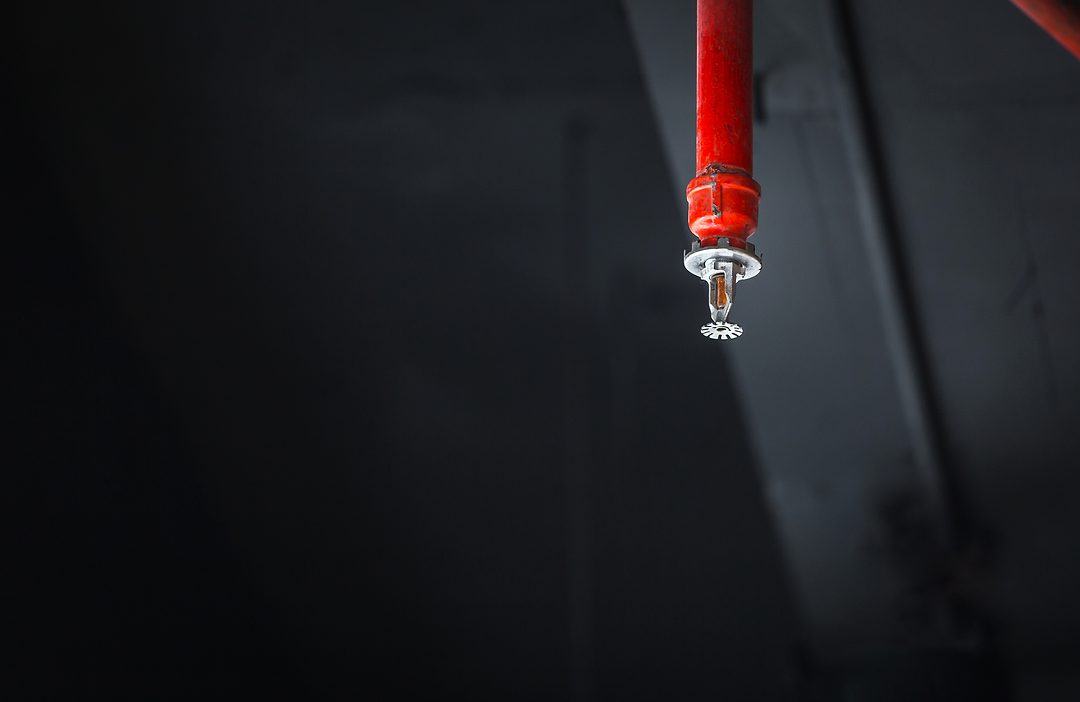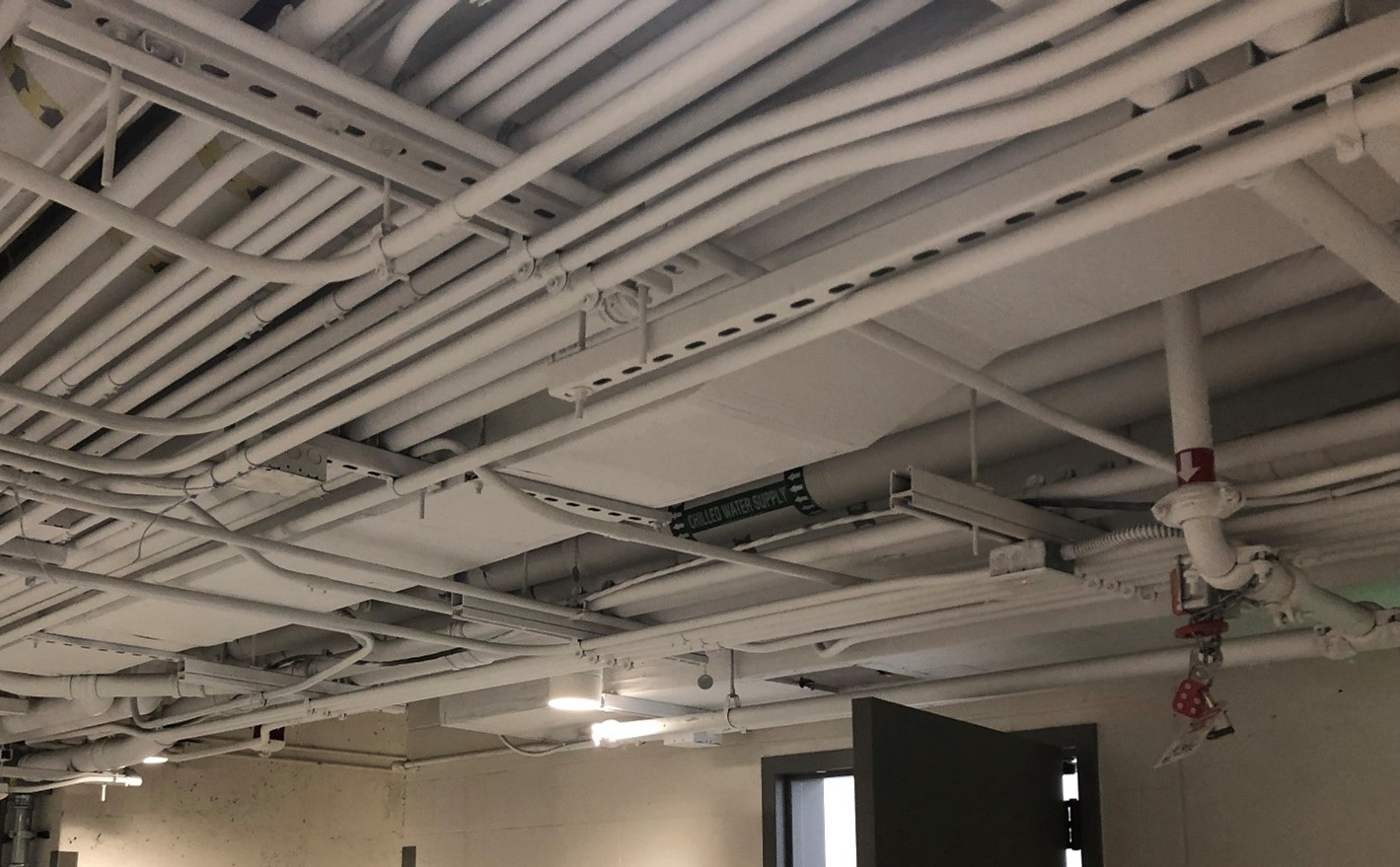The Great Debate: Can Sprinklers be Omitted from Certain Building Features?
Understanding NFPA 13 will allow engineers to omit fire sprinklers from certain building design aspects without compromising life safety protection.

As designers, we are often challenged in designing a code-compliant sprinkler system while keeping the aesthetic goals of an architect in mind. In particular applications, it may be acceptable to omit sprinklers without compromising life safety and, in many instances, is favorable as it reduces the visual impact that sprinklers can create. Although we hope there is an understanding between architect and engineer that not all sprinklers can be eliminated, this article outlines different rules and best practices related to cloud ceilings, ceiling pockets, skylights, enclosures and grouped obstructions more than 4 feet in width that are often discussed.
Cloud ceilings are a difficult architectural element to design around for many reasons. By their design, there are always going to be small gaps between the hung ceiling clouds. Illustrated in Figure 1, those gaps can allow smoke, heat and combustion byproducts to seep through, which can effectively increase the amount of time before a sprinkler would activate.
 LEAD Technologies Inc. V1.01
LEAD Technologies Inc. V1.01As such, there are scenarios where two levels of sprinklers are required to protect the space above and below the hung ceiling clouds. Until 2016, there was no official guidance in NFPA 13 on how to design around cloud ceilings. However, since then, NFPA 13 has given specific parameters that detail where sprinklers above the cloud ceiling can be omitted.
Section 9.2.7 of NFPA 13 outlines that there are multiple design parameters that need to be met in order to omit sprinklers above cloud ceilings. First, the combined total areas of the openings around the cloud must be less than or equal to 20 percent of the area of the ceiling, construction feature or plane used to determine the boundaries of the compartment.
All sprinklers associated with the cloud ceiling must be quick response pendent or upright sprinklers. The cloud ceiling height must not exceed 20 feet, and the spaces above the cloud ceiling must contain noncombustible or limited combustible construction with minimal combustible
loading.
There is one more requirement that must be followed in order to omit sprinklers above the cloud ceiling. Table 9.2.7.1 of NFPA 13 dictates the maximum sprinkler protection area under a cloud ceiling, which is based on the width between gaps (or between gaps and an adjacent wall) for a cloud ceiling, the dimensions of the ceiling cloud and the height of the ceiling cloud above the finished floor.
At first glance, this table might seem difficult to work with. For that reason, we can work through an example. Let’s say we have a 10-foot x 10-foot room. Hung from the ceiling are four 4-foot 6-inch x 4-foot 6-inch clouds, with a 6-inch gap between them and a 6-inch gap between the clouds and the outer walls of the room. The cloud ceilings are 10 feet off the ground.
We need to determine the minimum width dimension of our ceiling cloud. Since we have 4-foot 6-inch x 4-foot 6-inch ceiling clouds, we can use the bottom row of the table. To determine which column of the table to use (which will give us our final answer of maximum sprinkler protection area), we need to find the ratio between the opening width (in inches) and the ceiling height (in feet).
The opening width for the ceiling clouds is 6 inches and the ceiling height is 10 feet; therefore, the ratio is 0.6 inches/foot of ceiling height. Using the corresponding column of the table, we can find the maximum coverage area for these sprinklers to be 150 square feet.
NFPA 13 does not explicitly state the maximum gap width for a cloud ceiling. However, we can surmise that because Table 9.2.7.1 does not outline details for if the opening width (in inches) to ceiling height (in feet) ratio is greater than 1.0 inches/foot, that ceiling orientation would not be permitted.
Ceiling Pockets and Skylights
Other ceiling features that are common in architectural design are ceiling pockets and skylights. Ceiling pockets can be found in areas where the ceiling is at a higher elevation than the rest of the floor. Skylights are often found on the ceiling of the highest floor in a building and act as a way to allow in additional natural light.
It is often preferable to omit sprinklers from ceiling pockets or skylights for a multitude of reasons — architects will almost always prefer fewer sprinklers for aesthetic reasons, whereas fire protection designers and contractors will prefer fewer sprinklers for hydraulic, coordination and construction reasons. It is important to familiarize oneself with the rules for omitting sprinklers in ceiling pockets and skylights.
Section 10.2.9 of NFPA 13 outlines its rules on the installation of sprinklers in ceiling pockets. It says that sprinklers shall be installed in all ceiling pockets unless all of the following rules are followed:
• The total volume of the ceiling pocket does not exceed 1,000 square feet.
• The depth of the ceiling pocket does not exceed 36 inches.
• The entire floor under the unprotected ceiling pockets is protected by sprinklers at the lower ceiling elevation.
• The total size of all unprotected ceiling pockets in the same compartment within 10 feet of each other does not exceed 1,000 square feet.
• The ceiling pocket has noncombustible or limited combustible finishes.
• Quick response sprinklers are used throughout the compartment.
A designer can apply these rules to help guide the design of ceilings for a space. If a ceiling pocket depth measures 37 inches, it would require sprinkler protection per Section 10.2.9. Suggesting a slight redesign of the ceilings to attain NFPA 13-compliant ceiling pockets would cut down on the required number of sprinklers, which will be advantageous aesthetically, hydraulically and economically.
On the other hand, it might be tempting to use the ceiling pocket rules as much as possible to appease other parties in the construction process — it is important to know when one can apply these rules. Identify the materials used in the ceiling’s construction to be sure that they are noncombustible or limited combustible (as defined elsewhere in NFPA 13).
In addition, be sure to look at the ceiling pocket as it relates to other ceiling pockets in the compartment to make sure that Clause 3 in the above NFPA section is satisfied. If there is no way to avoid the use of sprinklers in a ceiling pocket, it is advisable to discuss the space with the architect, who might request the use of a concealed sidewall sprinkler to best avoid aesthetic obstruction to the space.
Skylights are a considerable area of concern regarding sprinkler design. Being able to omit sprinklers from skylights is almost certainly going to be the goal of any architect. Unfortunately, there are fairly strict rules about sprinklers in skylights per NFPA standards. Section 9.3.16.1 dictates that sprinklers can be omitted from a skylight not exceeding 32 square feet in area, as long as it is separated by at least 10 feet horizontally from any other unprotected skylight or ceiling pocket.
Though easy to interpret, the NFPA rules surrounding skylights can often be difficult to apply. In a world dictated by fire protection designers, we might opt to put a sprinkler in the skylight and move on. Practically, this might not be an acceptable option; it is advantageous to discuss skylights as early on as possible in the course of the design.
It likely won’t be feasible to change the size of the skylights. However, a discussion can begin on how to best “hide” the sprinkler from view. One example of skylight sprinkler design is the use of a concealed sidewall sprinkler hidden behind a false façade. Other options that may suit different projects better are seen in Figure 3.

Enclosures, Grouped Obstructions
Starting with the 2019 edition, Section 9.2.10 of NFPA 13 was explicit in not requiring sprinklers within electrical/mechanical equipment enclosures that were not intended for occupancy, such as a generator or air-handling unit enclosure. The 2022 edition has expanded to include language for furniture and cabinets as well as small temporarily occupied enclosures.
Furniture, cabinets, lockers or similar areas that are not intended for occupancy do not require sprinklers; however, sprinklers in the surrounding area are required to be located such that coverage is provided to the wall behind this furniture. Similarly, sprinklers are not required in small, isolated, temporarily occupied enclosures (up to 24 square feet) that do not extend to the ceiling and have no storage.
As a designer, it has been clear since the very early editions of NFPA 13 that sprinklers are required under a fixed obstruction more than 4 feet in width. However, MEP equipment is often grouped in the main corridors of the building. This creates a situation where fixed obstructions are individually under 4 feet in width but collectively combined are more than 4 feet in width and are running below the elevation of the ceiling sprinklers (see Figure 4).

Are additional sprinklers required beneath these fixed obstructions that collectively combined are more than 4 feet in width? Unfortunately, NFPA 13 does not provide direction in this situation. Engineering judgment must be applied in making the determination for each particular application.
Some authorities having jurisdiction will consider this an obstruction that prevents sprinkler discharge from reaching the hazard and require additional sprinklers below the fixed obstructions that collectively combined are more than 4 feet in width. It is important to identify this potential condition during the design process and address it as may be required for the application and jurisdiction.
NFPA 13 sets forth the minimum requirements for the design and installation of sprinkler systems. Good working knowledge of the standard will inform where sprinklers can be omitted from the design without compromising a reasonable degree of life safety protection. Understanding how to apply the requirements allows designers to influence the sprinkler system design to make it code-compliant, economically mindful and as aesthetically pleasing as possible.
Jack DeVine, EIT, is a fire and life safety consultant in Arup’s Boston office. He has a master’s degree in fire protection engineering from Worcester Polytechnic Institute. He has growing experience in fire sprinkler and fire alarm design, as well as code consulting, egress modeling, and performance-based fire modeling.
Robert Accosta Jr., PE, is a licensed fire protection engineer in Arup’s New York office and serves as an alternate member on the NFPA 13 Technical Committee on Sprinkler System Installation Criteria. His expertise focuses on fire protection systems design and life safety code consulting from project inception through beneficial occupancy and closeout. Robert is the Past President for Society of Fire Protection Engineers, New York Metropolitan Chapter.




